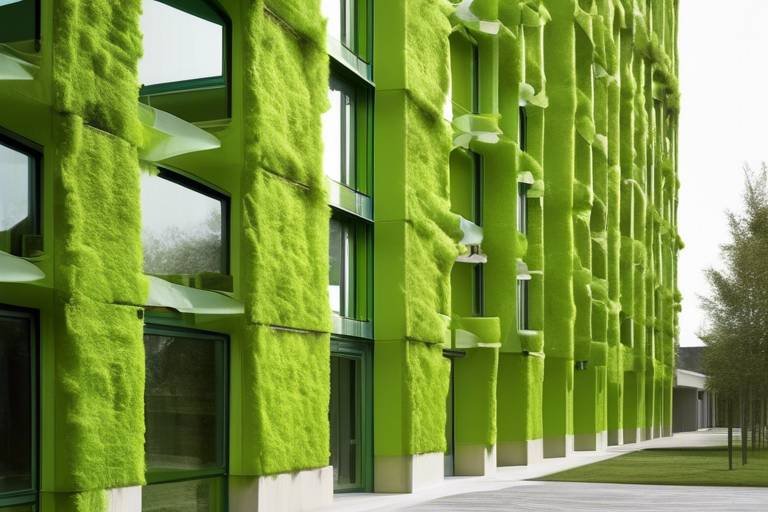How Green Energy is Impacting Architectural Design
In today’s world, the conversation around architecture is evolving dramatically, and at the heart of this transformation is green energy. As we face the pressing challenges of climate change, the architectural community is stepping up to the plate, integrating sustainable practices and innovative technologies into their designs. But what exactly does this mean for the future of our buildings? It’s not just about aesthetics; it’s about crafting spaces that are environmentally friendly and energy-efficient.
Architects are now prioritizing designs that not only meet the needs of their clients but also respect the planet. This shift towards sustainability is not merely a trend; it’s becoming a fundamental principle in the architectural field. Buildings are being designed with an emphasis on minimizing their ecological footprint while maximizing their livability. Imagine living in a home that not only provides comfort but also contributes positively to the environment—this is the future that green architecture promises.
One of the most fascinating aspects of this movement is the integration of renewable energy sources into architectural design. From solar panels that harness the sun’s energy to geothermal systems that utilize the Earth’s natural heat, architects are finding innovative ways to make buildings self-sufficient. This not only reduces reliance on fossil fuels but also leads to significant cost savings in energy bills over time. As a result, we are witnessing a paradigm shift where buildings are becoming more than just structures; they are evolving into self-sustaining ecosystems.
Moreover, the push for green energy is leading to a re-evaluation of materials used in construction. Traditional materials are being replaced with eco-friendly alternatives that offer superior performance while being less harmful to the environment. For instance, recycled steel, bamboo, and rammed earth are gaining popularity as sustainable options. These materials not only reduce waste but also enhance the overall energy efficiency of buildings. It’s a win-win situation that architects are eager to embrace.
As we continue to explore the impact of green energy on architectural design, it’s essential to recognize the role of energy-efficient technologies. Advancements such as smart home systems, energy management tools, and high-efficiency HVAC systems are revolutionizing how we think about energy consumption in buildings. These technologies allow for real-time monitoring and optimization of energy use, ensuring that buildings operate at peak efficiency. Picture a home that adjusts its heating and cooling based on your daily routine—this level of adaptability is becoming a reality thanks to green energy innovations.
In conclusion, the influence of green energy on architectural design is profound and far-reaching. It represents a shift towards a more sustainable future where buildings are not just places to live and work but also contributors to the health of our planet. As we continue to innovate and adapt, the possibilities for green architecture are limitless, paving the way for a brighter, more sustainable tomorrow.
- What is green architecture? Green architecture refers to sustainable building practices that minimize environmental impact and enhance energy efficiency.
- How does green energy influence architectural design? Green energy encourages the use of renewable resources, eco-friendly materials, and energy-efficient technologies in building design.
- What are some examples of sustainable materials? Examples include recycled steel, bamboo, and rammed earth, which are used to reduce waste and improve energy efficiency.
- What technologies support energy efficiency in buildings? Technologies such as smart home systems, energy management tools, and high-efficiency HVAC systems help optimize energy use.
- Why is community engagement important in architectural projects? Involving local stakeholders can lead to more sustainable and accepted architectural solutions, ensuring that designs meet the needs of the community.

1. The Rise of Sustainable Architecture
Sustainable architecture is not just a trend; it's a movement that is reshaping our cities and communities. As the world grapples with the consequences of climate change, architects are stepping up to the plate, prioritizing environmental responsibility in their designs. Imagine a world where buildings not only provide shelter but also contribute positively to the environment. This vision is becoming a reality as architects embrace sustainable practices that minimize ecological impact while enhancing livability.
The principles of sustainable architecture revolve around a few key concepts. First and foremost is the idea of energy efficiency. Buildings are designed to use less energy, which translates to lower utility bills and a reduced carbon footprint. This is achieved through thoughtful design, the use of innovative materials, and the integration of advanced technologies. Architects are increasingly considering the lifecycle of materials, opting for those that are renewable, recyclable, or have a lower environmental impact. For instance, using reclaimed wood or recycled steel can significantly cut down on the resources needed for new construction.
Another important aspect is the incorporation of natural light and ventilation. By maximizing the use of daylight, buildings reduce their reliance on artificial lighting, which not only saves energy but also creates healthier living environments. Imagine walking into a space flooded with sunlight, where fresh air circulates freely, making you feel more connected to the outdoors. This connection is not just pleasant; it has been shown to improve mental well-being and productivity.
Moreover, sustainable architecture often incorporates green spaces, such as rooftop gardens and vertical forests. These elements not only enhance the aesthetic appeal of buildings but also contribute to urban biodiversity, helping to mitigate the heat island effect in cities. Communities benefit from these green spaces, as they provide areas for recreation and relaxation, fostering a sense of community and well-being among residents.
As we look to the future, the rise of sustainable architecture represents a paradigm shift in how we approach building design. It's not merely about constructing buildings; it's about creating environments that promote sustainability, resilience, and harmony with nature. The benefits are clear: healthier living spaces, reduced environmental impact, and a more sustainable future for generations to come. With each innovative design, architects are proving that sustainability and beauty can coexist, inspiring a new wave of eco-conscious living.

2. Innovative Materials for Eco-Friendly Design
In the ever-evolving landscape of architectural design, the use of innovative materials has taken center stage, driving the movement towards eco-friendly buildings. These materials are not just a trend; they represent a profound shift in how we think about construction and sustainability. Imagine walking into a building that not only looks stunning but also plays a crucial role in minimizing environmental impact. This is the promise of modern architecture, where the materials used can significantly reduce a structure's carbon footprint.
One of the most exciting developments in this field is the rise of sustainable materials. These materials are designed to be both functional and environmentally friendly. For instance, recycled steel is becoming a popular choice due to its strength and durability, allowing architects to create robust structures without depleting natural resources. Similarly, bamboo is gaining traction as a fast-growing alternative to traditional hardwoods, providing a renewable resource that can be harvested without harming the ecosystem.
Another game-changer is the use of insulating concrete forms (ICFs). These forms not only provide structural integrity but also offer exceptional insulation properties, reducing the need for heating and cooling systems. By using ICFs, architects are able to create energy-efficient buildings that maintain comfortable temperatures year-round, thus lowering energy consumption significantly.
Additionally, the integration of green roofs and living walls into architectural designs is becoming increasingly popular. These elements not only enhance the aesthetic appeal of buildings but also improve air quality, reduce urban heat, and promote biodiversity. Imagine a city where buildings are adorned with lush greenery, creating a vibrant urban ecosystem that benefits both residents and wildlife alike.
Moreover, biocomposite materials, made from natural fibers and bio-based resins, are emerging as an alternative to conventional plastics and composites. These materials are biodegradable and can be sourced sustainably, making them a fantastic option for eco-conscious builders. As technology advances, the potential for these materials to revolutionize construction practices becomes even more promising.
To illustrate the impact of these innovative materials, let's take a look at a few examples:
| Material | Benefits | Applications |
|---|---|---|
| Recycled Steel | Durable, reduces waste | Structural framework |
| Bamboo | Fast-growing, renewable | Flooring, furniture |
| Insulating Concrete Forms | Energy-efficient, strong insulation | Walls, foundations |
| Green Roofs | Improves air quality, reduces heat | Roofing systems |
| Biocomposites | Biodegradable, sustainable | Interior finishes, furniture |
In conclusion, the shift towards using innovative materials in architectural design is not just a passing phase; it is a necessary evolution that aligns with our collective responsibility to protect the planet. As architects embrace these materials, they are not only enhancing the beauty and functionality of buildings but also paving the way for a more sustainable future. By choosing materials that are environmentally friendly, we can create spaces that are not only livable but also contribute positively to the world around us.
- What are eco-friendly materials? Eco-friendly materials are those that have a minimal impact on the environment, either through sustainable sourcing, energy efficiency, or recyclability.
- How do innovative materials contribute to energy efficiency? Innovative materials often have superior insulation properties or are sourced from renewable resources, helping to reduce energy consumption in buildings.
- Can I use these materials in residential projects? Absolutely! Many innovative materials are suitable for residential construction and can enhance both aesthetics and sustainability.
- What is the future of eco-friendly architecture? The future looks bright, with continuous advancements in technology and materials that prioritize sustainability and environmental responsibility.

3. Energy-Efficient Technologies
When we think about the future of architecture, one thing is clear: energy-efficient technologies are at the forefront of this evolution. These technologies not only help in reducing energy consumption but also significantly lower the carbon footprint of buildings. Imagine living or working in a space that not only meets your needs but also contributes positively to the environment. Sounds dreamy, right? Well, this dream is becoming a reality thanks to advancements in energy-efficient technologies.
One of the most notable innovations in this realm is the use of solar panels. These sleek, shiny panels are not just a trend; they are a powerful tool that harnesses the sun’s energy to power homes and buildings. By converting sunlight into electricity, solar panels can dramatically reduce reliance on fossil fuels. In fact, buildings equipped with solar power systems can achieve up to 70% reduction in their energy bills. Isn't that a win-win situation?
Another exciting development is the integration of smart systems. These systems include everything from smart thermostats to automated lighting controls. They work by learning the habits and preferences of the occupants, optimizing energy use without sacrificing comfort. For instance, a smart thermostat can adjust the heating and cooling of a building based on whether it's occupied or not, leading to substantial energy savings. It's like having a personal assistant for your energy consumption!
Moreover, energy management tools are becoming increasingly sophisticated. These tools provide real-time data on energy usage, allowing building managers to identify inefficiencies and make informed decisions. For example, a Building Management System (BMS) can monitor and control various building systems, such as HVAC, lighting, and security, all from a central interface. This integration not only enhances operational efficiency but also promotes sustainability.
To give you a clearer picture, let’s take a look at a table summarizing some of the most impactful energy-efficient technologies:
| Technology | Description | Benefits |
|---|---|---|
| Solar Panels | Convert sunlight into electricity | Reduce energy bills, lower carbon footprint |
| Smart Thermostats | Automatically adjust temperature based on occupancy | Increase comfort, save energy |
| Building Management Systems (BMS) | Monitor and control building systems | Enhance efficiency, reduce operational costs |
In addition to these technologies, energy-efficient appliances are also making waves in modern architecture. From refrigerators to washing machines, these appliances are designed to consume less energy while delivering the same performance. By choosing energy-efficient appliances, homeowners can further reduce their energy consumption and contribute to a more sustainable future.
As we embrace these innovations, it's essential to recognize that the integration of energy-efficient technologies is more than just a trend; it's a necessity for sustainable living. By investing in these technologies, architects and builders are not only creating structures that are better for the environment but also enhancing the quality of life for their occupants. So, the next time you step into a building that feels just right—think about the technology working behind the scenes to make it all happen!
- What are energy-efficient technologies? Energy-efficient technologies are systems and devices designed to use less energy while providing the same level of performance.
- How do solar panels work? Solar panels convert sunlight into electricity through photovoltaic cells, which generate energy when exposed to sunlight.
- What is a Building Management System (BMS)? A BMS is a centralized system that monitors and controls various building systems, such as heating, ventilation, air conditioning, lighting, and security.
- Can energy-efficient technologies save money? Yes, by reducing energy consumption, these technologies can significantly lower energy bills over time.

4. Biophilic Design Principles
Biophilic design is more than just a trend; it's a movement that seeks to reconnect people with nature in our built environments. Imagine walking into a space where the air feels fresher, the light is softer, and the sounds of nature are harmoniously integrated into your surroundings. This is the essence of biophilic design, which emphasizes the incorporation of natural elements into architectural spaces to enhance the well-being of occupants. By integrating features such as natural light, greenery, and organic materials, architects can create environments that not only look beautiful but also promote health and sustainability.
One of the core principles of biophilic design is the use of natural light. Large windows, skylights, and open spaces allow sunlight to flood interiors, reducing the need for artificial lighting and creating a warm, inviting atmosphere. Think about how you feel on a sunny day; the warmth of the sun can uplift your mood and energize your spirit. This principle is all about harnessing that natural energy to create spaces that feel alive.
Another vital aspect is the incorporation of greenery. This could mean anything from indoor plants to green roofs. Plants not only purify the air but also add a touch of tranquility to any space. Research shows that environments rich in greenery can lead to increased productivity, reduced stress levels, and improved overall health. Imagine working in an office surrounded by lush plants and natural views; it’s a game-changer for mental clarity and creativity!
Biophilic design also emphasizes the use of natural materials. Wood, stone, and other organic materials can create a sense of warmth and comfort. These materials not only have aesthetic appeal but also contribute to sustainability. When sourced responsibly, they can reduce the carbon footprint of a building significantly. For example, reclaimed wood not only tells a story of its past but also minimizes waste and promotes recycling.
The connection to nature doesn’t stop at visuals; it extends to sounds and scents as well. Incorporating water features, such as fountains or small ponds, can create soothing sounds that mimic a natural environment. The gentle sound of flowing water can reduce stress and create a serene atmosphere. Additionally, using materials that emit natural scents, like cedar or eucalyptus, can enhance the sensory experience of a space.
To truly grasp the impact of biophilic design, consider its benefits:
- Improved Well-being: Spaces designed with biophilic principles can significantly enhance mental and physical health.
- Increased Productivity: Natural elements in the workspace can lead to higher levels of focus and creativity.
- Enhanced Aesthetics: Incorporating nature into design creates visually appealing spaces that feel more inviting.
In conclusion, biophilic design principles are reshaping the way we think about our living and working spaces. By embracing nature in architecture, we’re not just designing buildings; we’re creating environments that nurture our well-being and foster a deeper connection to the world around us. As we continue to face urbanization and environmental challenges, the importance of biophilic design will only grow, reminding us that nature is an essential part of our lives.
What is biophilic design?
Biophilic design is an architectural approach that seeks to connect people with nature through the incorporation of natural elements, such as light, greenery, and organic materials, into built environments.
How does biophilic design benefit health?
Research suggests that biophilic design can improve mental health, reduce stress, and enhance overall well-being by creating environments that feel more natural and inviting.
Can biophilic design be applied in urban areas?
Absolutely! Biophilic design can be integrated into urban settings through green roofs, vertical gardens, and the use of natural materials in construction, allowing city dwellers to enjoy the benefits of nature even in densely populated areas.

5. The Role of Government Policies
Government policies play a pivotal role in shaping the landscape of green architecture. As the world becomes increasingly aware of environmental issues, policymakers are stepping up to create regulations and incentives that encourage sustainable building practices. These policies are not just guidelines; they are the backbone of the movement towards eco-friendly architecture, ensuring that developers and architects have the necessary support to innovate responsibly. For instance, many governments have introduced tax incentives for buildings that meet specific energy efficiency standards. This not only makes green construction more appealing but also helps offset the often higher upfront costs associated with sustainable materials and technologies.
Moreover, regulations such as building codes and zoning laws are evolving to include requirements for sustainability. These codes often mandate the use of energy-efficient systems and materials, pushing architects to think creatively about their designs. In some regions, governments have set ambitious targets for reducing carbon emissions, which in turn influences local building regulations. For example, a city might require that all new constructions meet a certain level of energy efficiency or include renewable energy sources like solar panels. Such mandates ensure that sustainability becomes an integral part of architectural design rather than an afterthought.
In addition to regulations, government initiatives often provide funding and resources to support green architecture. This can come in the form of grants for research and development of new sustainable technologies or financial assistance for projects that aim to reduce their environmental footprint. These initiatives can significantly lower the barriers to entry for architects and builders who want to adopt green practices but may be deterred by costs or lack of knowledge. By facilitating access to resources, governments can foster a culture of innovation and sustainability within the architectural community.
To illustrate the impact of government policies on green architecture, consider the following table that outlines various types of policies and their effects on sustainable building practices:
| Policy Type | Description | Impact on Green Architecture |
|---|---|---|
| Tax Incentives | Financial benefits for buildings that meet energy efficiency standards. | Encourages investment in sustainable materials and technologies. |
| Building Codes | Regulations that mandate certain energy efficiency levels. | Ensures sustainability is a baseline requirement for new builds. |
| Funding Programs | Grants and financial assistance for green projects. | Reduces financial barriers for adopting eco-friendly practices. |
| Public Awareness Campaigns | Government-led initiatives to educate the public about sustainability. | Increases demand for green buildings and practices. |
In conclusion, the role of government policies in promoting green architecture cannot be overstated. They create a framework that encourages sustainable practices, making it easier for architects to design buildings that are not only functional but also environmentally responsible. As these policies continue to evolve, they will undoubtedly play a crucial part in shaping the future of architecture, driving innovation, and fostering a culture of sustainability that benefits everyone.

6. Case Studies of Green Buildings
When it comes to green architecture, real-world examples can speak volumes about the potential and impact of sustainable design. Let's dive into some remarkable case studies that highlight how innovative architectural practices are reshaping our built environment while promoting energy efficiency and sustainability. These projects not only showcase stunning aesthetics but also demonstrate how effective green design can be in reducing energy consumption and minimizing ecological footprints.
One of the standout examples is the Bosco Verticale in Milan, Italy. This residential building features two towers adorned with over 9,000 trees and 20,000 plants. The design not only enhances the building's aesthetic appeal but also improves air quality and provides insulation. The vegetation absorbs CO2, reduces noise pollution, and helps regulate temperature within the apartments. The integration of nature into the architectural fabric of the building creates a unique living environment that promotes well-being and sustainability.
Another impressive project is the One Central Park in Sydney, Australia. This development includes a pair of residential towers that incorporate green roofs and vertical gardens, which are designed to improve biodiversity and provide residents with a connection to nature. The design cleverly utilizes solar panels and rainwater harvesting systems, significantly reducing the building's reliance on non-renewable energy sources. Residents enjoy natural light and ventilation, contributing to a healthier living space.
In the United States, the Bullitt Center in Seattle is often referred to as the greenest commercial building in the world. This six-story office building is a model of sustainability, featuring a solar array that generates more energy than the building consumes. Additionally, it utilizes rainwater harvesting for its water needs, and its design incorporates natural ventilation, reducing the need for air conditioning. The Bullitt Center is a testament to how innovative design can lead to remarkable energy efficiency.
To further illustrate the impact of these green buildings, here's a quick comparison of their key features:
| Building | Location | Key Features | Energy Efficiency |
|---|---|---|---|
| Bosco Verticale | Milan, Italy | Vertical gardens, CO2 absorption | Reduces energy consumption by enhancing insulation |
| One Central Park | Sydney, Australia | Green roofs, rainwater harvesting | Significantly lowers reliance on non-renewable energy |
| Bullitt Center | Seattle, USA | Solar array, natural ventilation | Generates more energy than it consumes |
These case studies exemplify the potential of green buildings to not only minimize their environmental impact but also enhance the quality of life for their occupants. They serve as powerful reminders that sustainable architecture is not just a trend; it’s a necessary evolution in how we design and interact with our environments. As we look to the future, we can expect to see more projects that blend innovative design with sustainable practices, ultimately reshaping our cities into greener, healthier spaces.
Incorporating green principles into architectural design is no longer a luxury; it's a necessity for a sustainable future. Each of these buildings is a beacon of hope, showing us that we can harmonize our living spaces with the natural world while still enjoying modern comforts. The journey towards a greener future is well underway, and these case studies provide a roadmap for others to follow.
- What are green buildings? Green buildings are structures designed to reduce their environmental impact and enhance the health and comfort of their occupants.
- How do green buildings save energy? They utilize energy-efficient technologies, renewable energy sources, and sustainable materials to minimize energy consumption.
- What are some benefits of living in a green building? Benefits include improved air quality, lower utility bills, and a stronger connection to nature, contributing to overall well-being.
- Are green buildings more expensive to build? While initial costs can be higher, the long-term savings on energy and maintenance often outweigh the upfront investment.

7. Challenges in Implementing Green Design
Implementing green design in architecture is a noble pursuit, but it's not without its challenges. As we strive to create buildings that are both sustainable and functional, architects often encounter a range of obstacles that can hinder the adoption of eco-friendly practices. One of the most significant challenges is the initial cost associated with sustainable materials and technologies. While these investments can lead to long-term savings on energy bills, the upfront costs can be daunting for both builders and clients.
Another challenge lies in the availability of materials. Not all regions have access to sustainable materials, which can lead to increased shipping costs and a larger carbon footprint. Additionally, the demand for eco-friendly products is rising, but supply chains are still catching up, creating potential delays in construction timelines. Architects must often navigate these logistical hurdles to ensure that their projects remain on schedule and within budget.
Regulatory hurdles are also a significant factor. Various building codes and zoning laws can restrict the use of innovative materials or technologies. Architects and builders must stay informed about local regulations, which can vary widely from one jurisdiction to another. This often requires additional time and resources to ensure compliance, which can detract from the focus on sustainable design.
Furthermore, there is sometimes a lack of awareness and education about green design among clients and stakeholders. Many people are still unfamiliar with the benefits of sustainable architecture, leading to skepticism about its practicality and effectiveness. Educating clients about the long-term advantages of green design, such as lower energy costs and improved indoor air quality, is crucial for overcoming this barrier.
Lastly, the integration of energy-efficient technologies can be complex. Smart systems for energy management, while beneficial, require a level of technical expertise that not all architects possess. This can lead to challenges in implementation and maintenance, potentially negating some of the benefits of going green. Architects must collaborate with specialists and invest time in learning about these technologies to fully harness their potential.
In summary, while the journey towards implementing green design is fraught with challenges, the potential rewards make it a worthwhile endeavor. By addressing issues such as cost, material availability, regulatory compliance, education, and technology integration, architects can pave the way for a more sustainable future in the built environment.
- What are the main challenges architects face when implementing green design?
The main challenges include initial costs, material availability, regulatory hurdles, lack of awareness among clients, and the complexity of integrating energy-efficient technologies. - How can architects overcome the high costs associated with green design?
Architects can help clients understand the long-term savings from energy-efficient designs and suggest phased implementations to spread costs over time. - Why is education important in promoting green architecture?
Educating clients and stakeholders about the benefits of sustainable design can help overcome skepticism and encourage investment in green technologies.

8. Future Trends in Green Architecture
The future of architecture is undeniably intertwined with sustainability, and as we look ahead, several exciting trends are emerging that promise to reshape our built environments. One of the most significant movements is the increasing adoption of smart building technologies. These technologies utilize advanced sensors and IoT (Internet of Things) devices to monitor and manage energy consumption in real-time, allowing buildings to adapt to changing conditions and optimize energy use. Imagine a building that can automatically adjust its heating and cooling based on occupancy levels or weather forecasts—this is not science fiction, but a rapidly approaching reality.
Another trend gaining momentum is the use of modular construction. This method involves prefabricating building sections off-site, which are then assembled on location. Not only does this approach reduce waste and construction time, but it also allows for greater precision and quality control. As architects and builders embrace modular techniques, we can expect to see a surge in eco-friendly buildings that are not only efficient but also aesthetically pleasing.
Moreover, the integration of renewable energy sources is becoming a standard expectation rather than an exception. Solar panels, wind turbines, and geothermal systems are increasingly being incorporated into building designs from the outset. This shift not only reduces reliance on fossil fuels but also empowers building owners to generate their own energy, leading to lower operational costs and a smaller carbon footprint.
In addition, the concept of circular architecture is gaining traction. This innovative approach emphasizes designing buildings with the end of their life cycle in mind. By utilizing materials that can be easily recycled or repurposed, architects are moving towards a model that minimizes waste and maximizes resource efficiency. For instance, imagine a building constructed with materials that can be disassembled and reused in future projects—this is the essence of circular architecture.
Furthermore, the focus on biophilic design continues to grow, with architects increasingly incorporating natural elements into their designs. This trend not only enhances the aesthetic appeal of buildings but also significantly improves the well-being of occupants. Features such as green walls, natural lighting, and water elements foster a connection with nature, which is essential in today’s urban environments.
Lastly, we cannot overlook the importance of community-centric design. As architects strive to create spaces that reflect the needs and desires of local populations, community engagement becomes paramount. This collaborative approach not only leads to more sustainable outcomes but also fosters a sense of ownership and pride among residents. By involving stakeholders in the design process, architects can create buildings that are not only environmentally friendly but also culturally relevant and accepted.
In summary, the future of green architecture is bright and filled with potential. With advancements in technology, innovative construction methods, and a commitment to sustainability, we can look forward to a new era of architectural design that prioritizes both the planet and its inhabitants.
- What is green architecture? Green architecture refers to a design philosophy that focuses on creating buildings that are environmentally responsible and resource-efficient throughout their life cycle.
- How does technology influence green architecture? Technology plays a critical role by enabling smart systems that optimize energy use, improve efficiency, and reduce waste in building operations.
- What are some examples of sustainable materials? Sustainable materials include bamboo, recycled steel, reclaimed wood, and low-VOC (volatile organic compounds) paints, all of which minimize environmental impact.
- Why is community engagement important in architectural design? Involving the community ensures that the designs meet the needs of local residents, leading to more successful and accepted projects.

9. The Importance of Community Engagement
When it comes to architectural design, community engagement is not just an optional add-on; it’s a crucial component that can make or break a project. Imagine trying to build a skyscraper in the middle of a quaint neighborhood without ever asking the residents what they think. Sounds chaotic, right? That’s precisely why involving the community in the design process is essential. It fosters a sense of ownership, encourages collaboration, and ultimately leads to projects that are not only functional but also resonate with the people who will use them.
Community engagement can take many forms, from public meetings and workshops to surveys and online forums. The goal is to gather input from local residents, business owners, and other stakeholders. This feedback helps architects and planners understand the unique needs and desires of the community, ensuring that the final design reflects those values. By prioritizing community input, architects can create spaces that are not only aesthetically pleasing but also enhance the quality of life for residents.
Moreover, involving the community can lead to more sustainable architectural solutions. When people feel that their voices are heard, they are more likely to support initiatives that promote sustainability. For example, a community might advocate for green spaces, pedestrian-friendly pathways, or public transportation options that reduce the carbon footprint of the area. This collaborative approach not only addresses environmental concerns but also strengthens community ties, making residents feel more connected to their surroundings.
To illustrate the impact of community engagement, consider the following table showcasing successful projects that incorporated local feedback:
| Project Name | Location | Community Input Method | Outcome |
|---|---|---|---|
| Green Park Revitalization | Springfield | Public Workshops | Increased green space and community events |
| Downtown Revamp | Hometown | Online Surveys | Improved walkability and local business support |
| New Community Center | Metro City | Focus Groups | Facilities tailored to local needs |
As seen in the table, the outcomes of these projects not only enhanced the physical landscape but also fostered a sense of community pride. When residents see their ideas reflected in architectural designs, it creates a powerful bond between them and their environment. This connection is critical for the long-term success of any architectural endeavor.
However, engaging the community is not without its challenges. Architects must navigate differing opinions, conflicting interests, and sometimes even resistance to change. Yet, overcoming these obstacles is vital. By creating a transparent dialogue and being open to feedback, architects can build trust and pave the way for innovative solutions that benefit everyone.
In conclusion, community engagement is a cornerstone of successful architectural design. It transforms buildings from mere structures into vibrant spaces that reflect the character and aspirations of the people who inhabit them. As we move forward in the realm of green architecture, let’s remember that the best designs are those that are shaped by the voices of the community.
- Why is community engagement important in architectural design? Community engagement ensures that architectural projects meet the needs and desires of the local population, fostering a sense of ownership and pride.
- How can architects effectively engage with the community? Architects can use various methods such as public meetings, surveys, and workshops to gather input and feedback from local residents and stakeholders.
- What are some challenges faced during community engagement? Challenges include differing opinions, conflicting interests, and resistance to change, but these can be managed through transparent communication and collaboration.
Frequently Asked Questions
- What is sustainable architecture?
Sustainable architecture refers to designing buildings with a focus on minimizing their environmental impact. It incorporates eco-friendly materials, energy-efficient technologies, and practices that promote long-term sustainability while enhancing the quality of life for occupants.
- How do innovative materials contribute to green architecture?
Innovative materials, such as recycled metals, bamboo, and rammed earth, are revolutionizing green architecture by reducing the carbon footprint of construction. These materials not only provide durability but also enhance energy efficiency, helping to create structures that are both functional and environmentally friendly.
- What are some examples of energy-efficient technologies?
Energy-efficient technologies include solar panels, smart thermostats, LED lighting, and energy management systems. These tools help optimize energy use in buildings, significantly lowering utility costs and reducing overall energy consumption.
- What is biophilic design and why is it important?
Biophilic design integrates natural elements into architectural spaces, aiming to create a connection between people and nature. This approach enhances well-being, reduces stress, and promotes sustainability, making environments healthier and more enjoyable for occupants.
- How do government policies influence green architecture?
Government policies play a crucial role in promoting green architecture through regulations, incentives, and funding programs. These measures encourage architects and builders to adopt sustainable practices and technologies, ensuring a collective effort towards environmental responsibility.
- Can you provide examples of successful green building projects?
Absolutely! Notable examples include the Bullitt Center in Seattle, which is known for its net-zero energy use, and the Bosco Verticale in Milan, which features vertical forests that improve air quality and promote biodiversity.
- What challenges do architects face when implementing green design?
Common challenges include high upfront costs, limited availability of sustainable materials, and navigating complex regulations. Architects must also educate clients about the long-term benefits to overcome resistance to investing in green design.
- What future trends are emerging in green architecture?
The future of green architecture includes trends such as the use of artificial intelligence for design optimization, increased adoption of modular construction, and a greater emphasis on circular economy principles, ensuring materials are reused and recycled effectively.
- Why is community engagement important in architectural projects?
Community engagement ensures that local stakeholders have a voice in the design process. This involvement leads to more accepted and sustainable solutions, as architects can better address the needs and preferences of the community they serve.



















